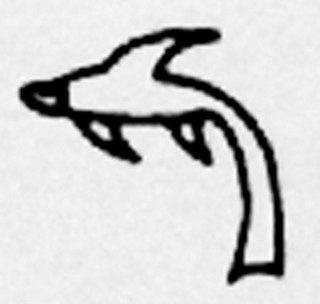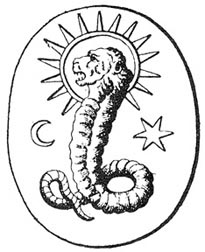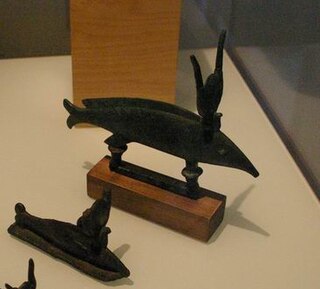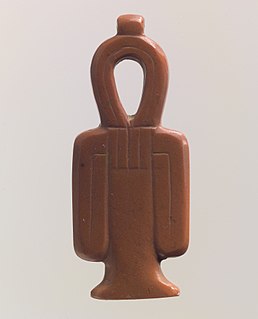 W
WAndjety is a local ancient Egyptian deity of the ninth nome, centered at Andjet, which was known as Busiris to the Greeks. This deity is also known by the alternative names Anezti or Anedjti. Andjety is considered one of the earliest Egyptian gods, possibly with roots in prehistoric Egypt.
 W
WAtef is the specific feathered white crown of the ancient Egyptian deity Osiris. It combines the Hedjet, the crown of Upper Egypt, with curly red ostrich feathers on each side of the crown for the Osiris cult. The feathers are identified as ostrich from their curl or curve at the upper ends, with a slight flare toward the base. They are the same feather as (singly) worn by Maat. They may be compared with the falcon tail feathers in two-feather crowns such as those of Amun, which are more narrow and straight without curve.
 W
WThe Atet was the solar barge of the sun god Ra in the mythology of the ancient Egyptians. It was also known as the Mandjet, the Boat of Millions of Years, and, during the night, as the Mesektet.
 W
WIn Egyptian mythology, Buchis was the deification of the kꜣ of the war god Montu as a sacred bull that was worshipped in the region of Hermonthis.
 W
WHatmehit or Hatmehyt in ancient Egyptian religion was a fish goddess in the area around the delta city of Per-banebdjedet. In ancient Egyptian art, Hatmehit was depicted either as a fish or a woman with a fish emblem or crown on her head. She was a goddess of life and protection.
 W
WThe horns of Ammon were a symbol of the Egyptian deity Ammon associated with the fossils shells of ancient snails and cephalopods, the latter now known as ammonite because of that historical connection.
 W
WHu, in ancient Egypt, was the deification of the first word, the word of creation, that Atum was said to have exclaimed upon ejaculating or, alternatively, his circumcision, in his masturbatory act of creating the Ennead.
 W
WIhy is a god in ancient Egyptian mythology who represents the ecstasy of playing the sistrum. His name may mean "sistrum player", referring to his function, or "calf". This is in allusion to his relationship with the cow goddess Hathor who was often said to be his mother. Other goddesses might be called his mother, however, including Isis, Sekhmet, and Neith. The god Horus is Ihy's father. Ihy was depicted as a child holding a sistrum or as a nude child with his finger in his mouth. He was worshiped alongside Horus and Hathor at Dendera. Hathor is his mother, and Horus is his father.
 W
WIn Egyptian mythology, Imset is a funerary deity and one of the Four sons of Horus. He is associated with the canopic jars, specifically the one that contained the liver. Because the Egyptians saw the liver as the seat of human emotion, the depiction of Imset was, unlike his brothers, not associated with any animal but always depicted as a mummified human. Isis was considered his protector and Imset himself was recognized as the patron of the direction of the south. Imset was also associated with a broken heart or death due to excess of emotions, thus his name being translated as "the kindly one" in ancient Egyptian.
 W
WIunit was a minor goddess in ancient Egyptian religion, whose name means "She of Armant". She is the consort of Montu.
 W
WIn Egyptian mythology, Kebechet is a goddess, a deification of embalming liquid. Her name means cooling water.
 W
WKneph is a motif in ancient Egyptian religious art, variously a winged egg, a globe surrounded by one or more serpents, or Amun in the form of a serpent called Kematef. Some Theosophical sources tried to syncretize this motif with the deity Khnum, along with Serapis and Pluto. Under the Greek theonym Chnuphis, this figure adopts a serpent-bodied, lion-headed ("leontoeidic") visage, being particularly common in magical artifacts in Late Antiquity. It is by proxy frequently associated with the Gnostic Demiurge.
 W
WIn Egyptian mythology the Matet boat was the first of two boats traveled in by Ra, the sun god as he traveled the sky daily with the sun on his head. During the period between dawn and noon, Ra occupies the Matet boat. During the period between noon and dusk Ra travels in the Seqtet boat. Ra travels the underworld during the night where he encounters and battles many foes. Matet and Seqtet seem to have many different spellings and Ra himself is often mixed with another or sometimes several deities dependent upon the period and various locations throughout ancient Egypt.
 W
WMedjed was a species of elephantfish worshipped at Oxyrhynchus in ancient Egyptian religion. These fish were believed to have eaten the penis of the god Osiris after his brother Set had dismembered and scattered the god's body. A settlement in Upper Egypt, Per-Medjed, was named after the fish and is now better known under its Greek name Oxyrhynchus.
 W
WMenhit was originally a Nubian war goddess in ancient Egyptian religion. Her name depicts a warrior status, as it means (she who) massacres.
 W
WMortuary temples were temples that were erected adjacent to, or in the vicinity of, royal tombs in Ancient Egypt. The temples were designed to commemorate the reign of the Pharaoh under whom they were constructed, as well as for use by the king's cult after death.
 W
WNebethetepet (nb.t-ḥtp.t) is an ancient Egyptian goddess. Her name means "Lady of the Offerings" or "Satisfied Lady". She was worshipped in Heliopolis as a female counterpart of Atum. She personified Atum's hand, the female principle of creation, but aside from that had little significance.
 W
WThe tyet, sometimes called the knot of Isis or girdle of Isis, is an ancient Egyptian symbol that came to be connected with the goddess Isis. Its hieroglyphic depiction is catalogued as V39 in Gardiner's sign list.
 W
WWadj-wer is an Egyptian god of fertility whose name means the "great green".